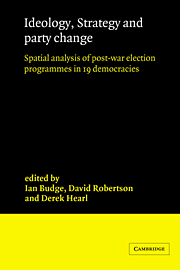 Ideology, Strategy and Party Change
Ideology, Strategy and Party Change Published online by Cambridge University Press: 27 October 2009
The purpose of this chapter is to shed new light on Japanese party politics by examining party pledges in general elections from 1960–80. First we locate our analysis in a broader substantive context. Then, on the basis of newspaper summaries of election pledges at general election times, we analyse how appeals are made to the general public by political parties, along the general lines followed elsewhere in the book.
THE PLACE OF PARTIES IN THE POLITICAL SYSTEM
Given the extensive changes produced by war and occupation in the 1940s, Japanese political practices display surprising continuity. Fundamental changes have taken place however within the context of existing institutions. Thus the 1947 constitution, which replaced that of 1889, declares that sovereignty lies with the people, not the Emperor, who remains however the symbol of Japan. The Diet, the Cabinet, and the Supreme Court, respectively, hold the highest legislative, executive and judicial powers. The Diet is composed of a House of Representatives (the main arena for legislation and politics) and a House of Councillors.
Parties also display some continuity. As institutions they evolved in opposition to the absolutist government of the pre-war era and until recently were weak in comparison to the state bureaucracy. Three factors shaped the new political parties after the war.
In 1946, after all constraints on the formation of political parties had disappeared, political competition extended to left-wing parties including the Japanese Communist Party (JCP). For the first time, such parties briefly held office in coalition governments either headed by, or including Socialists.
[…]
To save this book to your Kindle, first ensure no-reply@cambridge.org is added to your Approved Personal Document E-mail List under your Personal Document Settings on the Manage Your Content and Devices page of your Amazon account. Then enter the ‘name’ part of your Kindle email address below. Find out more about saving to your Kindle.
Note you can select to save to either the @free.kindle.com or @kindle.com variations. ‘@free.kindle.com’ emails are free but can only be saved to your device when it is connected to wi-fi. ‘@kindle.com’ emails can be delivered even when you are not connected to wi-fi, but note that service fees apply.
Find out more about the Kindle Personal Document Service.
To save content items to your account, please confirm that you agree to abide by our usage policies. If this is the first time you use this feature, you will be asked to authorise Cambridge Core to connect with your account. Find out more about saving content to Dropbox.
To save content items to your account, please confirm that you agree to abide by our usage policies. If this is the first time you use this feature, you will be asked to authorise Cambridge Core to connect with your account. Find out more about saving content to Google Drive.